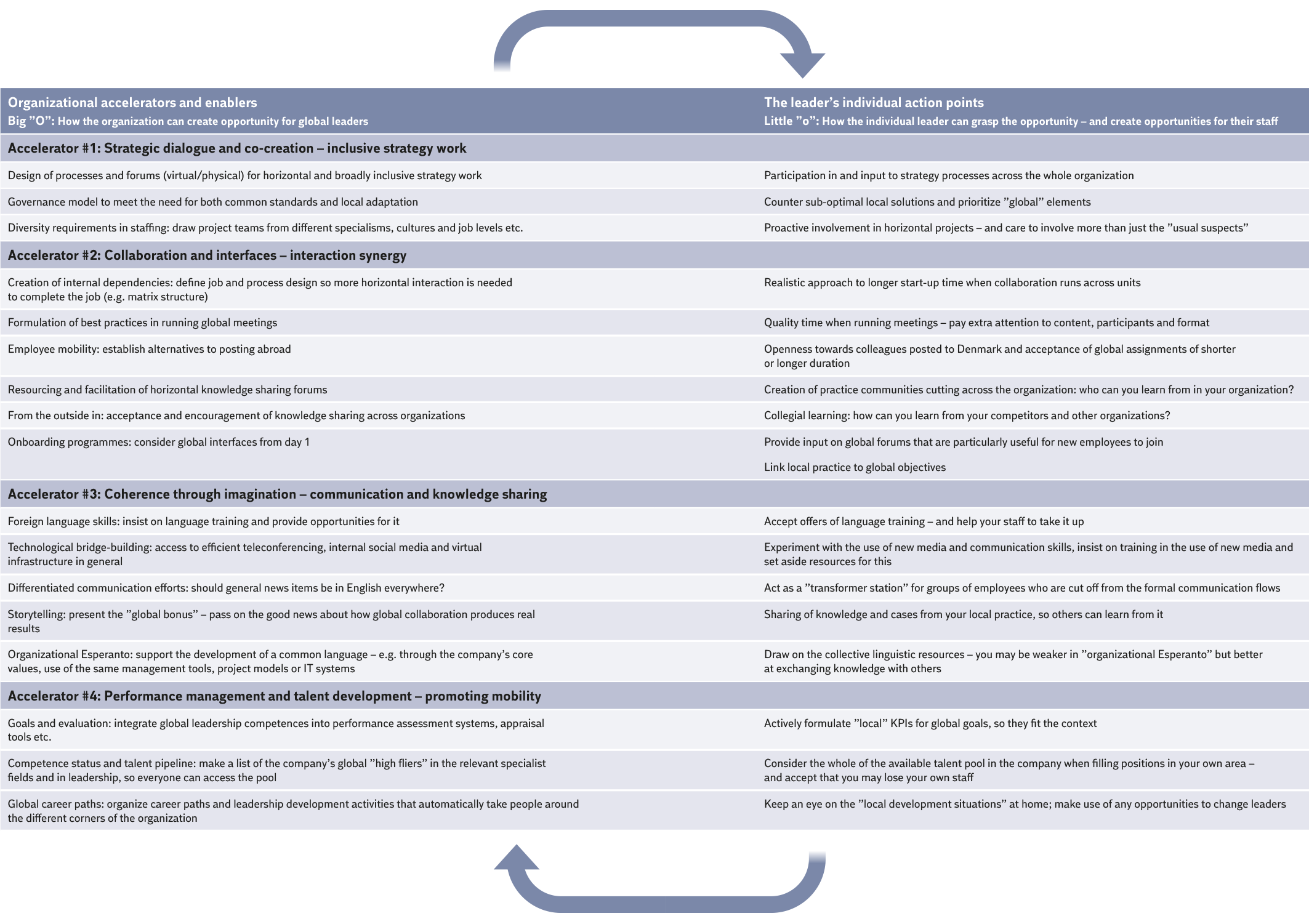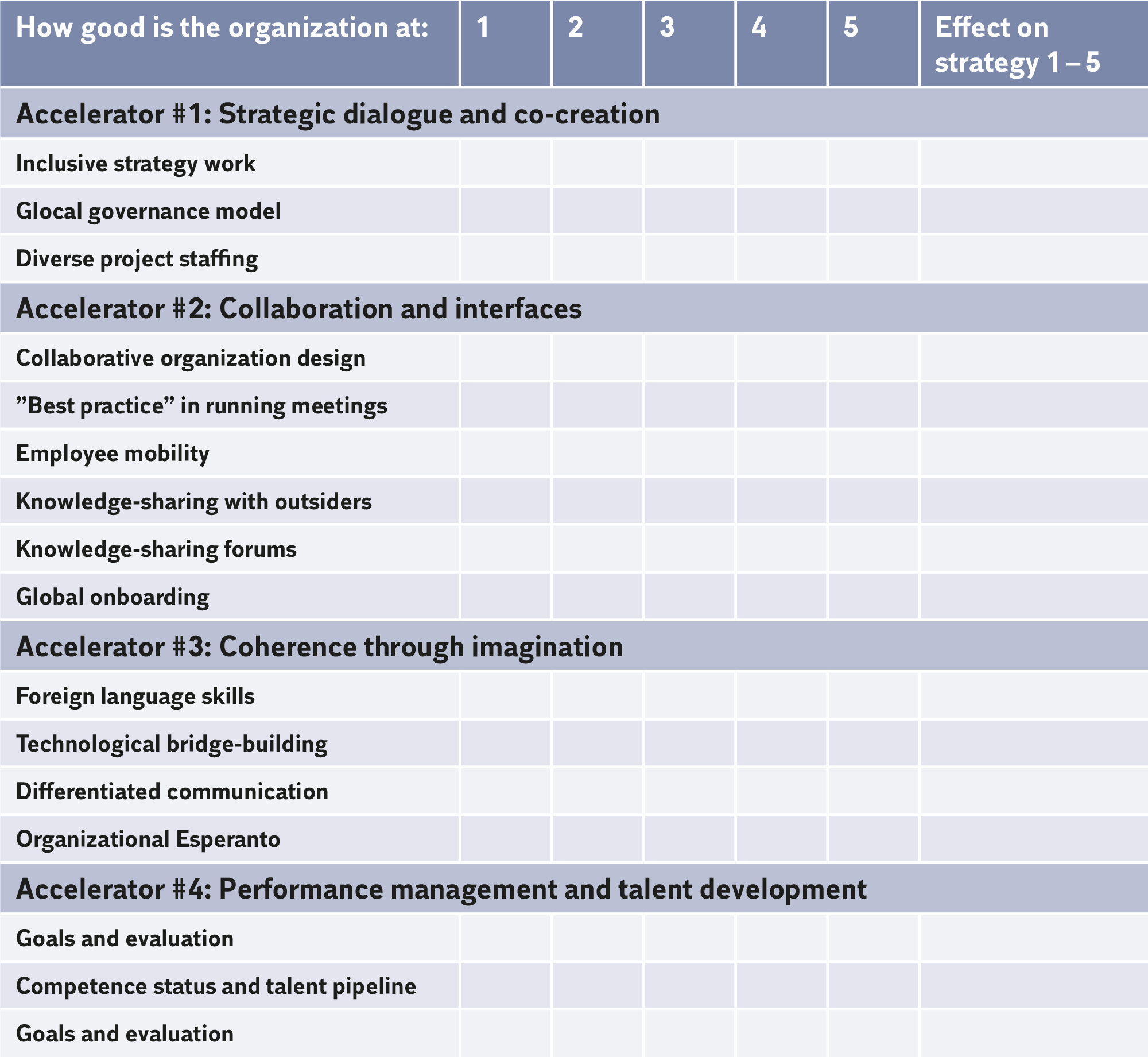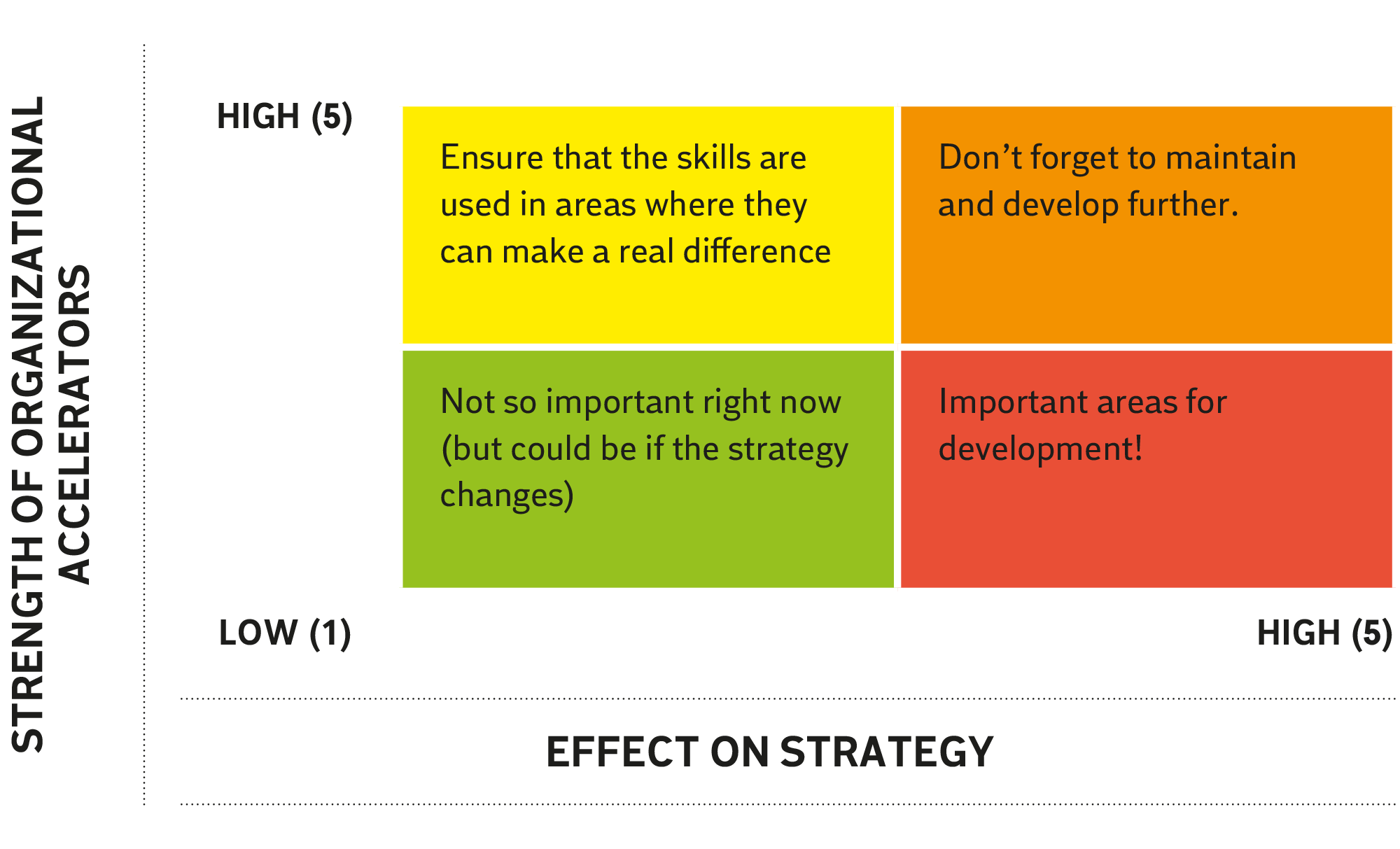Tool 11
Why: Both global practitioners and researchers have traditionally been very concerned to identify particular personality traits and competences that are especially critical for global leaders. So they have typically focused on ability and motivation, with less attention given to the design of the working conditions and the organization’s contribution to successful global leadership by way of supporting measures. There is now increasing interest in what is called ”enablement”, i.e. facilitating and accelerating global leadership. This enablement implies a dedicated effort to support global leadership through the company’s systems, structures and processes as a supplement to and accelerator of the individual leader’s global skillset.
What: The tool presents the global enablement model, inspired by two of the Academy’s research projects, which outlines global leadership accelerators and their synergy effects in the combination of the individual global leader (action/activity) and organizational support structures and systems which go far beyond classical competence development. The global enablement model can be used as an ”inspiration catalogue” and as a yardstick for evaluating organizational readiness in terms of promoting successful global leadership, including the ways in which the opportunities created by the organization can be grasped and driven forward by the individual leader.
How and who: Corporate HR will often be the process owner when it comes to designing and facilitating actions to accelerate and support global leadership across companies. However, the actual execution of these measures is generally well outside the HR sphere of influence, so it is important for managers and HR to determine 1) what measures are to be taken to facilitate global leadership, and 2) the concrete division of responsibilities and KPIs between HR and leaders.
The researchers Boxall and Purcell proposed what they call a performance equation. Equation is perhaps too strong a word – it might be better described as a rule of thumb to identify the different components which all need to be in place to achieve performance in global leadership or other situations. The equation, which is also known as the ”AMO” model, uses three basic elements of performance:
A: Ability
M: Motivation
O: Opportunity
The ”equation” element is the idea that performance occurs as a function of all three elements, so A × M × O = Performance. It should be noted that all three elements have to be present to obtain a positive result: if any one of the three elements is 0, the other elements will be multiplied by 0 to give 0, i.e. no performance.
The bulk of the literature on global leadership and of the interest from global practitioners has so far been concentrated on the ”A” (ability) and the ”M” (motivation), in terms of how these elements could be captured and developed through e.g. personality testing and traditional competence development activities such as global leadership development programmes. The ”O”, on the other hand, has been a more neglected presence, but as the performance equation shows, all three elements are equally important: one could imagine many situations where people are no doubt capable and willing enough but never get the chance to use their resources, because there is not the right space, because they are spending their energy on the ”wrong” thing, or because they are not proactive in using the space that is there.
In this tool, we drill down into the ”O” element of global leadership; how to create ”opportunity” with a view to facilitating global leadership performance. The individual and the organizational view are represented in a model of global leadership accelerators below, which suggests possible ways of promoting global performance.
We have extended the view taken in the AMO model, in that we are operating with a ”double O”, where ”Opportunity” in the sense of scope for action is viewed in both an individual and an organizational perspective:
Big ”O”: The working conditions, systems and structures that form the organizational context around global leadership
Little ”o”: The leadership behaviour required to grasp and exploit the opportunities
The figure below shows global leadership accelerators at both the individual and the organizational level together. It should be noted here that the arrows at the top and bottom of the model indicate that individual behaviour and organizational support structures and processes influence each other. The model draws on two research projects carried out under the auspices of the GLA. In different ways, each of these projects addressed the relationship between individual global competence and organizational facilitation and bridge-building in terms of linking individual global performance and organizational performance, and the discussions that these research projects raised in workshops at the Academy.

Figure 11.1: Global leadership accelerators and synergy effects in the interplay between global leader and global organization
It is now time to judge whether and how your company is exploiting the opportunity to create the conditions that are conducive to a global outlook and action. This means that it could be smart for various stakeholders each to make their own assessment, to set the stage for a collective evaluation of the organization’s use of accelerators and of their effectiveness; this would include identifying the areas of the company’s strategy where there is a need for more action.
The first step is to rate the organization’s global leadership accelerators on a scale from 1 to 5, where 1 is low and 5 is high, then use the result to assess the effect of these accelerators on the company’s strategy (also on a scale from 1 – 5) in order to identify actions that the company can usefully designate as priority areas and to allocate resources to strengthen these (the column on the far right):

Figure 11.2: Assessment of organizational readiness to learn broken down by global leadership accelerators
The results for the effect of the individual accelerators on the company’s strategy (the right-hand column above) can be entered into the matrix below to provide a general overview of what to do more or less of in the future.

Figure 11.3: Priority areas for organizational facilitation of global leadership
The process concludes with drawing up a plan with relevant actions in order of priority. It is impossible to develop and change everything all at once, so it is important to stick to these priorities, even though all of them may seem equally important.
Draw up a prioritized development plan, and be realistic. It is a good idea to choose no more than two or three areas to work on at any one time – and rather two than three. Revisit the tool at regular intervals
.Boxall, P. & Purcell, J. (2011). Strategy and human resource management. Hampshire, England: Palgrave-Macmillan.
Bird, A.; Broundal, M.; Hansen, P. G.; Maznevski, M.; Mortensen, E.; Nielsen, R.K.; Poulfelt, F. (2016). Exploring the Individual-Organizational Global Mindset Nexus: A MNC- Practitioner-Academia Dialogue. Academy of Management Proceedings: Academy of Management Proceedings. Vol. 2016.
Nielsen, R.K. (2017). Global Mindset in Context: Middle Manager Microfoundations of Strategic Global Mindset. Academy of Management Proceedings, Vol. 2017, The Academy of Management, 2017.
Nielsen, R.K. & Bird, A. (Eds.) (forthcoming). Connecting Individual and Organization Global Mindset in Theory and Practice. Frontiers in Global Management Series. Emerald Publishing Group.
Nielsen, R.K. (2014). Ledelse med globalt mindset – lederkompetencer i det globale. In F. Poulfelt (ed.), Børsens Ledelseshåndbøger, Strategi & Ledelse. Copenhagen: Børsens Publishing.
Nielsen, R.K. (2014). Global Mindset as Managerial Meta-competence and Organizational Capability: Boundary-crossing Leadership Cooperation in the MNC. The Case of ”Group Mindset” in Solar A/S. Doctoral School of Organization and Management Studies, PhD Series; 24, 2014.